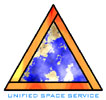 The Portable Universe 6
The Portable Universe 6by Michael P. Kube-McDowell
 The Portable Universe 6
The Portable Universe 6originally published in
The Elkhart Truth
May 28, 1983
The suspense is half over.
Science fiction's writing community has tabbed 38-year-old Michael Bishop as the winner of the 1982 Nebula Award for best science fiction novel. The honored work is "No Enemy But Time," which first appeared in hardcover last year but has just been reprinted in paperback (Timescape, $3.50). The Nebula was Bishop's second, though his first in the novel category. The award is given by the 500-strong Science Fiction Writers of America, which counts among its members nearly every major and minor SF writer from Asimov to Zelazny.
Now it's a matter of waiting for the fans to drop the other shoe. The readers' award is known formally as the Science Fiction Achievement Award, but is better known as the Hugo--after SF's founding spirit, Hugo Gernsback, who in the 1920s published the first SF magazine.
The Hugo Awards will be announced in September at the World Science Fiction Convention, but even before then the nominees make up a classy recommended reading list. Start with new books by three old masters: "Friday" by Robert Heinlein (Holt), "2010: Odyssey Two" by Arthur C. Clarke (Del Rey), and "Foundation's Edge" by Isaac Asimov (Doubleday), all $14.95 in cloth.
If your bookbuying budget is tight, you might start with Gene Wolfe's "Sword of the Lictor" (Timescape, $2.95), the third volume of his highly praised Book of the New Sun, or C.J. Cherryh's skillful portrayal of an alien space captain in "Pride of Chanur" (DAW, $2.95). But I'd recommend you put Donald Kingsbury's "Courtship Rite" (Timescape, $8.95 trade) at the top of your list. This splendid story of conflict between human tribes who include in their religion the "lost art" of genetic engineering would be a fit crowning for many writers' careers--but it's Kingsbury's first novel.
When consideration of next year's awards rolls around, I hope to see Sydney J. van Scyoc's science fantasy "Bluestone" on the short list. In fact, I intend to nominate it myself for both the Hugo and the Nebula. Van Scyoc's first novel of the planet Brakrath, "Darkchild," got crowded out of the 1982 awards picture thanks in part to a November release and to the many big names on the list of eligibles. But the two books taken together make for the most original and enjoyable bit of reading I've done in six months. Brakrath was settled by human survivors of a space wreck, but since that time, the planet as changed them more than they have changed it.
Gregory Benford won a lot of converts, myself among them, with his 1980 novel "Timescape," which portrayed scientists in 1998 desperately seeking the aid of scientists in 1962 in heading off a world-wide ecological disaster.
In "Beyond Infinity" (Timescape, $14.95) Benford downplays the science and plays up the rite of passage of a young boy on Ganymede, the largest moon of Jupiter. Being a first-generation native on a world being transformed for mankind is challenge enough. But Manuel Lopez also comes face to face with the Aleph, a huge alien artifact which roams the icy wastes without apparent purpose or pattern. Benford's portrayal of how genetically engineered animals could be used to reshape a world provides a fascinating backdrop to the story.
As I write this, the eagerly awaited premiere of the third Star Wars film, "Return of the Jedi," is less than two weeks away. But the novelization (Del Rey, $2.95) showed up today in my mailbox, complete with a "fabulous 8-page color insert." Can I resist reading it until I've seen the movie? You bet. I'm not even going to look at the pictures. Well, not closely, anyway.
Short-fiction fans might consider editor Roy Torgeson's "Chrysalis 10" (Doubleday, $11.95 cloth) or Jessica Amanda Salmonson's "Heroic Visions" (Ace, $2.75). Torgeson shuns labels for his selections, but promises to take us beyond the so-called real world in which we live. The collection includes a story by 1983's double Nebula winner Connie Willis. The Salmonson book is a noble effort to raise the tenor of heroic fantasy, and features a new appearance by Fritz Leiber's popular character, the Gray Mouser.
Finally, your attention is directed to Peter Nicholls' readable and well-illustrated non-fiction book "The Science in Science Fiction" (Knopf, $14.95 trade). Any fan of the Clarke-Hogan-Clement school of technologically-oriented SF should make a point of getting their hands on this book. It's a perfect guide to just how far one should suspend belief when faced with star drives, time travel, androids, and other SFnal trappings. The last chapter enumerates some of the howlers of print and film, including hollow earths, lusty aliens, and shrinking men.
But, Pete, I still want Luke Skywalker's X-Wing to go "Whooosh!"
--Michael Kube-McDowell is a member of the Truth staff.
![]() Return to
Portable Universe Archive
Return to
Portable Universe Archive
Created: 12 March 2005
Last Revised: 07 July 2009